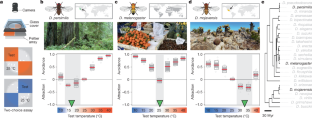果蝇属蝇类温度偏好的进化
IF 48.5
1区 综合性期刊
Q1 MULTIDISCIPLINARY SCIENCES
引用次数: 0
摘要
对特定温度范围的偏好是决定动物物种分布的关键因素。然而,在新环境的殖民过程中,我们对温度偏好行为的演变知之甚少。在这里,我们表明至少有两种不同的神经生物学机制驱动果蝇属的温度偏好的进化。来自温和气候的蝇类(黑腹蝇和persimilis)避免无害和有害的热,我们发现分子热受体Gr28b的热激活阈值。D精确匹配特定物种的行为热回避阈值。我们发现,生活在沙漠中的莫贾伐沙鼠反而会被无害的热量所吸引。值得注意的是,热吸引也由Gr28b介导。D(以及表达它的触角神经元),并匹配它的热激活阈值。相反,从热厌恶到吸引的价态转换与侧角的热感觉输入的特定变化有关,侧角是中枢热感觉通路的主要目标,也是苍蝇大脑中与先天价态加工有关的区域1,2,3,4,5。总之,我们的研究结果表明,在果蝇中,对不同热生态位的适应涉及热偏好行为的变化,这可以通过不同的神经生物学解决方案来实现,范围从外周热感觉受体蛋白激活阈值的变化到大脑中处理温度价的方式的重大变化。本文章由计算机程序翻译,如有差异,请以英文原文为准。


Evolution of temperature preference in flies of the genus Drosophila
The preference for a particular thermal range is a key determinant of the distribution of animal species. However, we know little on how temperature preference behaviour evolves during the colonization of new environments. Here we show that at least two distinct neurobiological mechanisms drive the evolution of temperature preference in flies of the genus Drosophila. Fly species from mild climates (D. melanogaster and D. persimilis) avoid both innocuous and noxious heat, and we show that the thermal activation threshold of the molecular heat receptor Gr28b.d precisely matches species-specific thresholds of behavioural heat avoidance. We find that desert-dwelling D. mojavensis are instead actively attracted to innocuous heat. Notably, heat attraction is also mediated by Gr28b.d (and by the antennal neurons that express it) and matches its threshold of heat activation. Rather, the switch in valence from heat aversion to attraction correlates with specific changes in thermosensory input to the lateral horn, the main target of central thermosensory pathways and a region of the fly brain implicated in the processing of innate valence1–5. Together, our results demonstrate that, in Drosophila, the adaptation to different thermal niches involves changes in thermal preference behaviour, and that this can be accomplished using distinct neurobiological solutions, ranging from shifts in the activation threshold of peripheral thermosensory receptor proteins to a substantial change in the way temperature valence is processed in the brain. A study using flies of the genus Drosophila adapted to life in diverse thermal environments shows how evolution has shaped temperature preference by acting on both molecular heat receptors and thermosensory circuits in the flies.
求助全文
通过发布文献求助,成功后即可免费获取论文全文。
去求助
来源期刊

Nature
综合性期刊-综合性期刊
CiteScore
90.00
自引率
1.20%
发文量
3652
审稿时长
3 months
期刊介绍:
Nature is a prestigious international journal that publishes peer-reviewed research in various scientific and technological fields. The selection of articles is based on criteria such as originality, importance, interdisciplinary relevance, timeliness, accessibility, elegance, and surprising conclusions. In addition to showcasing significant scientific advances, Nature delivers rapid, authoritative, insightful news, and interpretation of current and upcoming trends impacting science, scientists, and the broader public. The journal serves a dual purpose: firstly, to promptly share noteworthy scientific advances and foster discussions among scientists, and secondly, to ensure the swift dissemination of scientific results globally, emphasizing their significance for knowledge, culture, and daily life.
 求助内容:
求助内容: 应助结果提醒方式:
应助结果提醒方式:


